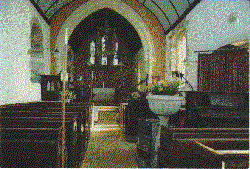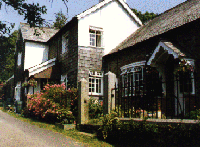VILLAGE OF CHARLES
The Imperial Gazetteer of England & Wales, Published
1867, has the following information on Charles:-
"CHARLES, a village and a parish in South Molton
district, Devon. The village stands on the river Bray, 5 miles NNW of South Molton, and 9 E of
Barnstaple r. station. The parish includes also the hamlet of Brayford. Post-town, South
Molton, North Devon. Acres, 2,429. Real property L2,527. Pop 356. Houses 75.
|
 |
ST. JOHN THE BAPTIST PARISH CHURCH,
CHARLES, NORTH DEVON
The property is subdivided. The manor belongs to Sir T.D.
Acland, Bart. The living is a rectory in the diocese of Exeter. Value L390. Patron the
Rev. R. Blackmore. The church is perpendicular English, with a tower." |
 |
CHURCH
HOUSE AT CHARLES Just in front of the
St. John the Baptist Church |
While I was in Devon in April 1995, I obtained a copy of a
small brochure, titled " A History of the Parish Church of St. John the Baptist,
Charles".
It reads as follows:-
When walking through the lovely lanes of Charles it is easy to feel a sense of history,
and indeed, for many centuries people have toiled and worshipped here. One of the best
known missionaries in the South West, St. Petrock, came here to minister to the Celtic
community nearly 1,500 years ago.
At Charles Bottom, by the bridge, there is a large menhir stone, probably a memorial,
thought to date from the Bronze Age. On it, R.D. Blackmore, the author of 'Lorna Doone'
often sat in the days when he lived with his grandfather and uncle at the Old Rectory,
Charles, and there composed some of his early poetry and prose.
The parish of Charles is of great antiquity. Its name derives from two Cornish words 'Carn
Lis', meaning 'Rocky Court, or Palace.' It was thus the headquarters of a Celtic chieftan
which survived the Saxon occupation. There is no trace of the 'palace', but tradition had
it that St. Petrock, a Welsh missionary, came to Charles in the 6th century, after
establishing a church at Parracombe. He built, beside the ancient track-way from
Barnstaple to North Molton, a wayside chantry in what is known as Walland Manor, and dug a
well which still exists. (When the Rev. W.W. Joyce was Rector he built himself a study at
St. Petrock's Cottage. It has a domed roof, and the well lies below the dome, sealed by a
stone slab).
When King Athelstan founded Pilton Priory about 925 A.D., monks from Pilton travelled from
the pack horse trackway via Barnstaple and Goodleigh to Charles through Middlecote Farm
and Hudley Mill, to conduct weekly services. Each Saturday evening they would make the
journey, staying overnight at the Priest's House, situated close to the present church. On
Sunday they would hear Confessions, and say Mass, returning to Pilton the same day. (The
records of Pilton Priory at the time of the Dissolution show 'the ferme of Middlecote' as
one of its properties). It is likely that the Prior and the monks of Pilton built the
parish church of St. John the Baptist, for the first mention of Charles as an
ecclesiastical foundation recorded the Prior as patron. The priory probably retained the
patronage till the time of the Reformation, but the chantry had earlier passed to the
Raleigh family who were lords of the manor of Walland.
The parish church was probably built soon after the Norman Conquest. The tower dates from
the Norman period, and the west light to the belfry may have been Norman until the tower
was encased in 1624. The two north windows were both Norman with a stone shaft dividing
each of them. The staircase door is Transitional. There was a screen across the chancel
until the building was restored in 1875, and in 1844 there was a gallery. Only an ancient
carved stone over the south door remains.
The font is hard freestone, and was given by Philip Ridgate in 1727, and the handsome
canopy was given by the parishioners as a War Memorial in 1919. There are several
memorials in the chancel. A brass plate marks the grave of John Blake who was Rector for
45 years until he died in 1614. There is a marble monument to the memory of the family of
George Gregorie who died in 1719 at the age of 87 after 56 years as Rector. On the south
wall is a marble tablet to the memory of the Rev. John Blackmore and his wife Mary who
were buried in the chancel 1842/3.
John Blackmore, a farmer's son, purchased the advowson of the living about 1780. He served
as Curate for many years, lived at the 'Old Rectory' and farmed the Parsonage Farm
adjoining. Unfortunately for him the living did not fall vacant until 1840. By this time
he was Rector of Combe Martin and Oare and, unable to undertake further responsibility, he
appointed his second son Richard to the living. His elder son John was for some unknown
reason passed over, and remained Curate of Ashford, near Barnstaple. But John's son,
Richard Doddridge Blackmore, loved to stay at Charles with his grandfather and Uncle
Richard, and regularly spent his holidays with them. When he was seventy years old he
wrote the following lines:
'Sometimes of a night, when the spirit of a dream slips away for a waltz with the shadow
of a pen over dreary moors and dark waters, I behold an old man with a keen profile under
a parson's shovel hat, riding a chestnut horse up the slopes of Exmoor, followed by his
little grandson upon a shaggy and stoggy pony. In the hazy fields of lower hills some four
or five miles behind them may be seen the ancient Parsonage, where the lawn is a russet
sponge of moss and a stream trickles under the dining-room floor, and the pious rook,
poised on the pulpit of his nest, reads a hoarse sermon to the chimney pots below'
Thus after sixty years, this lovable man remembered the Old Rectory at Charles, and his
travels with his grandfather, under whose ministry he worshipped so often in this Church.
Here with his remarkable memory, he gathered the Exmoor lore which he incorporated so
graphically in 'Lorna Doone'.
In 1925 local people subscribed for a new East window to commemorate the centenary of Mr.
Blackmore's birth. It consists of three lancets, showing St. John the Baptist, The Good
Shepherd and St. Petrock. The appeal and the centenary celebrations were organised by
Parson Joyce who became Rector in 1916. In his time many improvements were made to the
interior of the church, and much of our knowledge of its history stems from his writings.
He was also responsible for the re-hanging and tuning of the bells. Five of these were
cast in 1733, and there is a tradition that a bell was brought from St. Petrock's chantry
when it was demolished in the reign of Henry VIII. It was recast and is thought to be the
present treble bell. In 1937 a tenor bell was given to commemorate the coronation of King
George VI, and also the launching of the S.S. Queen Mary. At the same time a ringing
chamber was formed, with a vestry below.
The small priest's house was, after the Reformation, re-named the Church
House, a place where entertainment and other functions were held after
benches and pews were introduced, making the church unsuitable for village activities. It
was also the parson's residence, until the 1870's when the Rev. William Henry Vivian
purchased and made over to the living the farm and house now known as Grange Farm. The
'Old Rectory' was later built, and the rectors lived there until the property was sold in
the time of Parson Joyce.
When Richard Blackmore became Rector he started a church school, and the Priest's House
with the poor houses and a piece of land belonging to Mr. Parramore was conveyed to the
Rector and Churchwardens as trustees for the building of the school room and a house for
the head teacher. Some part of the ancient church house may have been incorporated in the
house, for some part of its walls are of cob, very thick and ancient.
There have been many changes in the pattern of life and of the population in Charles and
it is interesting to note that most of the village of Brayford is in the large parish of
Charles, far removed from the ancient site of the church. In recent times the population
of the parish has dwindled with the lessening of agricultural employment. The congregation
was so reduced that the Diocesan Pastoral Committee proposed in 1971 that the church
should be declared redundant and closed. However, there was strong local opposition to
this course of action, and the enthusiasm of the congregation together with the greater
flexibility of ministry made possible when Charles became one of the parishes of the South
Molton Group in 1975, made it possible for the decision to be changed. An energetic
programme of improvements was put in hand, carried out almost entirely by voluntary effort
on the part of parishioners, especially the late Mr. Alan Holway, who planned the interior
redecoration and undertook a large part of the work himself. The attractive interior is a
tribute to the talents and generosity of local people, and the restoration work is still
continuing: the complete repainting of the tower, and the repair of interior woodwork are
jobs which will require professional skills.
The ministry at Charles is now provided by the members of the South Molton Team Ministry,
and the clergy and congregation are determined that this ancient building with so much
history shall be preserved. They will value your prayers and support.
1991.
Can anyone help me
with more information?
"Australia @ War" WWII Research Products

This page last updated 21 February 2020





